Are you a tradie who works long hard hours doing physical work?
Do you often get:
- Sore body & tiredness
- back pain especially in the lower pack region
- upper body pain around the neck and shoulders?
Most likely you’ve been overworking yourself without giving your body enough rest, nutrients and conditioning. Hi, I’m Brian a Physiotherapist from Primal Physiotherapy. Every day I treat clients who work in your industry ranging from sparkies, chippies all the way to dunny divers. Most come in with pain aching all over their body and it becomes so painful that they cannot work but still have to push through to put food on the table. If you’re in a similar situation I completely understand, we all have to pay the bills and keep up with life.
Here are some common injuries I see in my clients every day.
- Gradual onset of low back pain associated with either long-duration standing, repetitive lifting tasks and sustained flexion positions
- Acute low back injuries (e.g. muscle strain, disc injuries) or reoccurring low back injuries from either single or multiple episodes of lifting heavy
- Lower limb traumatic (e.g. from fall at the worksite, twisting on the knee, ankle sprains) or non-traumatic injuries (e.g. overloading-type pain from climbing up/down ladders, squatting and lifting heavy loads)
- Neck, upper back and shoulder overloading- type pain and discomfort from performing significant amounts of sustained overhead tasks and overhead carrying.
- Gradual onset of pain in upper limb extremities (e.g. tennis elbow from repetitive hammering) associated with heavy demands of workload on upper limb muscles.
What happens if these injuries are left untreated to a tradie like me?
Depending on the type and extent of an injury, if left untreated, the injury or pain can become reoccurring or even worsen, which may impact profoundly on performance at work. Worst case scenario is for you to take significant time off from work. Although rest may temporarily aid with reducing pain, however resting is not the most optimal long-term solution to improve capacity and function. For an effective long-term approach to improve capacity and function with work tasks, an optimal approach is one that is individualized according to the tradies work demands and requirements, and which includes a combination of short-term and long-term strategies in return to a full work function. I’m going to recommend some basic stretches that are easy to do, however, seeing a Physiotherapist directly will improve your recovery time a thousand times faster. So it’s worth the time out in the day to book an appointment to get expert advice and apply an active plan to improve your mobility, strength and recovery time-frame. *These are generalized recommended stretches and exercises; which do not take into account a wide range of individual presentations and rehab needs. If these stretches or exercises exacerbate your symptoms, please cease pushing through with the stretches and exercises, and consult a physical therapist or health professional regarding your pain/ injury for a thorough assessment and treatment.
Low back pain- disc-related problems and injuries
Stretch #1 – Standing Cobras
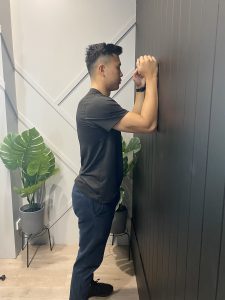
Physiotherapy Standing Cobra Step 1 performed by Brian Lee at Primal Physiotherapy
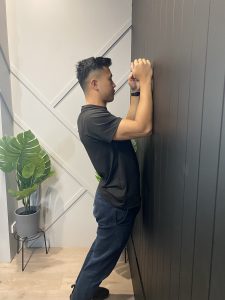
Physiotherapy Standing Cobra Step 2 performed by Brian Lee at Primal Physiotherapy
This exercise will help to:
- Provide lumbar spine extension to offload the pressure of your lower back and disc
- Minimize muscle guarding and promote movement
Lay on your stomach with your hands underneath your shoulders and elbows placed near your body. Push through your hands to extend your low back and upper body as far as you can tolerate. Lower yourself down to starting position and repeat for 2-3 rounds of 10 repetitions. Note: to regress push through your forearms instead to reduce range of motion Focus:
- Keep moving within a comfortable range
- Hands in line with chest, but can bend elbows if too restricted
- Keep hips down and relax glutes
*This exercise should help centralize/reduce distal pain down your legs, or improve your low back pain and range of motion. If this exercise exacerbates your leg pain symptoms or low back pain, please cease continuing with this exercise.
Stretch #2 – Knee to Chest
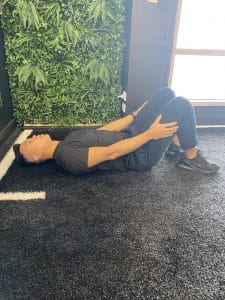
Physiotherapy Stretch Knee to Chest Step 1 performed by Brian Lee at Primal Physiotherapy
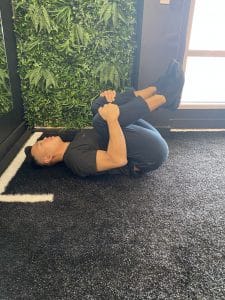
Physiotherapy Stretch Knee to Chest Step 2 performed by Brian Lee at Primal Physiotherapy
This exercise will help to:
- Lengthen the lower back muscles.
- Promote gentle movement without increasing pain excessively.
Lay on your back bringing your knees towards your chest. Place your hands below your knees pulling them gently towards your chest and hold for 2 seconds. Complete 10 repetitions 3 times a day.
Stretch #3 – Seated Twist
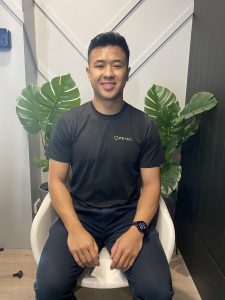
Physiotherapy Stretch Seated Twist Step 1 performed by Brian Lee at Primal Physiotherapy
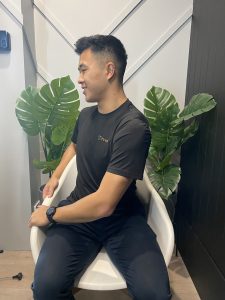
Physiotherapy Stretch Seated Twist Step 2 performed by Brian Lee at Primal Physiotherapy
This exercise will help to:
- Reduce stiffness in the lower back.
- Promote movement without increasing pain excessively.
Sitting in your chair cross your legs and twist towards the leg that is stacked on top of the other. Twist as far as you can tolerate. Hold this for 30 seconds each side prior to work and often during the day if your pain persists.
Stretch #4 – Core Bracing
This exercise will help to:
- Improve core strength.
- Reduce the chances of hurting your back when bending and lifting.
You can be sitting or standing for this exercise. Tighten up your stomach like you are about to be hit in the stomach. Brace your stomach for 5-10 seconds and then release. Repeat for 2-3 rounds for 10 reps prior to work. This is also a good technique to use when bending and lifting at work. Just brace your core using the previous instructions while you’re lifting or bending and then relax once you have completed the lift.
Neck and upper back overloading-type pain/ discomfort
Stretch # 5 – Chin Tucks
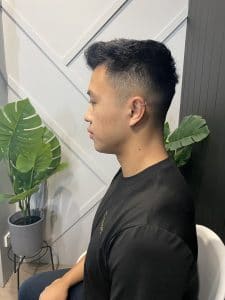
Physiotherapy Stretch Chin Tucks Step 1 performed by Brian Lee at Primal Physiotherapy
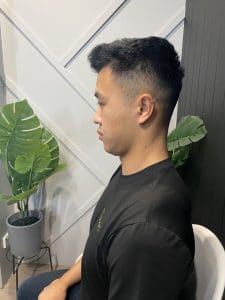
Physiotherapy Stretch Chin Tucks Step 2 performed by Brian Lee at Primal Physiotherapy
Engage your deep neck flexor muscles which reside in the front of your neck. One of the common cause of neck pain and headaches is weakness or inability to activate the deep muscles at the front of your neck. This is a great easy starting point prior to progressing to more demanding exercises. To understand the motion of the chin tuck is this “think about someone smashing a pie in your face and your head is moving straight back to avoid it”. This is a straight back and GENTLE movement. Don’t let your head extend or flex as you tuck your chin in.
Stretch #6 – Upper Traps Stretch
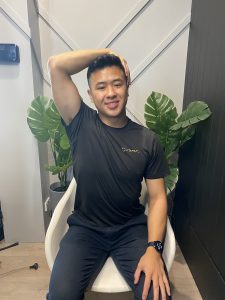
Physiotherapy Upper Traps Step 1 performed by Brian Lee at Primal Physiotherapy
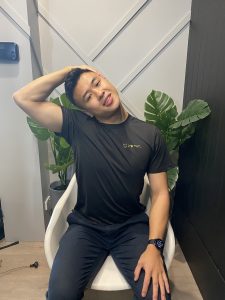
Physiotherapy Upper Traps Step 2 performed by Brian Lee at Primal Physiotherapy
This stretch targets the upper traps (the region between shoulder and neck). If you have any tightness or fatigue in this region from work, this stretch will help you to relieve those tight sensations in this region. Hold the stretch for 10-15 seconds each. For a bigger stretch set up with your hand (on the side to be stretched) underneath your buttocks (this helps to depress your shoulder) and then use your other free hand to pull your neck to the opposite shoulder.
About Brian
Brian graduated from Latrobe University with a Bachelor of Health Science and Masters in Physiotherapy Practice. Brian is a certified strength and conditioning coach having worked with a range of athletes from Olympic to casual level. Brian enjoys training at the gym as he believes that this is the best way to give you the results you need to get your injuries back on track. When not in the clinic, Brian loves to shoot some hoops!
Our Locations
Primal Physiotherapy Braybrook 10/227 Ballarat Rd Braybrook VIC 3019 (03) 9995 8044 https://primalphysiotherapy.com.au/braybrook Primal Physiotherapy Taylors Hill 127 Gourlay Rd Taylors Hill VIC 3037 (03) 8315 7182 https://primalphysiotherapy.com.au/taylors-hill Primal Physiotherapy Camberwell 782 Burke Rd Camberwell VIC 3124 (03) 9973 3090 https://primalphysiotherapy.com.au/camberwell
